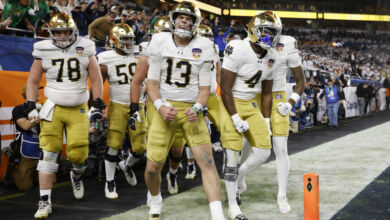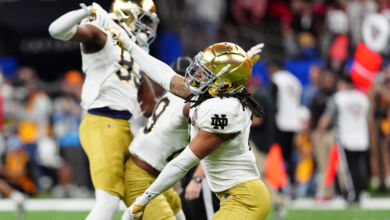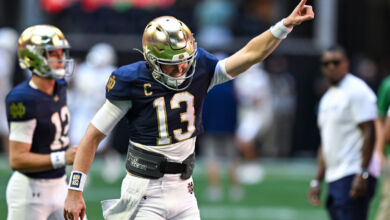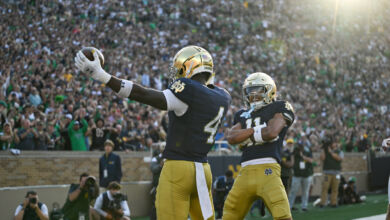NOTRE DAME, IN (UHND.com) – For the past 43 seasons, Notre Dame has come out victorious in its annual matchup with the Midshipmen of Navy and if there was ever a season in which the Irish desparatley wanted that streak to continue, it would be this one. The Irish enter Saturday’s contest sporting a 1-7 record with hopes of turning around a season that has seen very little well for them. Fortunately for Notre Dame, Navy will bring a defense which has yielded 150 points over its last three games which could be just what the doctor ordered to nurse an ailing offense back to health.
|
|||||||||||||||||||||||||||||||||||||||||||||||||||||||||||||||||
After eight games this season, Notre Dame has managed to score just 80 total points. Last week the Midshipmen gave up 59 in one game to the D1AA Delaware Blue Hens. Something’s got to give Saturday.
Many expect the Irish to come out and run the ball early and often to take advantage of the clear size advantage the Irish offensive line has on a Navy defensive front that averages just 261 pounds along the line and 220 pounds in the linebacking corps.
The size advantage the Irish have is not lost on Navy head coach Paul Johnson. “They have a huge offensive line and they will have a big size differential against us. I am sure they will try and get their running back going and I’m sure they will toss it deep a few times as well, everybody we play does,” he said earlier this week.
Notre Dame will also have the benefit of having leading rusher James Aldridge return from an ankle injury that sidelined him for the USC game to pound the ball against a defense that is surrendering 178.9 (82nd in the NCAA) yards a game on the ground.
“It was encouraging watching him run around,” Weis said on Tuesday. “I also let him know last week that it was going to be important for him Monday to be able to run around so we could see we could count on him. Judging him yesterday, he’s ready to go.”
With Aldridge healthy, expect to see a lot of him early to soften up the Navy defense because of his size and power. Armando Allen could be a big factor in this game as well because of his speed. He showed some signs of improvement at the end of the USC game and against a defense like Navy’s he could make a few big plays if he gets the ball in some open space.
All of this would make it seem rather obvious that the Irish will try to run it all day long, but Navy’s pass defense might be even more suspect than it’s run defense and could present the Irish with a chance to fix a passing game that is gaining just 153.5 yards a game through the air.
Pass protection has been one of the biggest reasons for Notre Dame’s struggles airing it out this season. Irish quarterbacks have been sacked an alarming 41 times this season for an average of just over 5 a game. Coincidentally, that is precisely how many sacks the Navy defense has register all year in 237 opponent pass attempts for an average of once every 47.5 attempts.
When given time to pass the ball, Evan Sharpley has made some plays for the Irish in comeback attempts against Purdue and Boston College and given time to pass on Saturday, he should continue to provide the Irish with some big plays through the air.
Against Delaware this past weekend, Navy bit on a number of pump fakes which resulted directly in two Delaware touchdowns. With big, physical wide receivers in Robby Parris and Duval Kamara starting for the Irish, watch for Weis to work the short passing game early to set up something similar to what Delaware had great success with. Both Parris and Kamara will have the size advantage over the Navy corners which could make the short passing game a nice weapon this weekend if either is able to break some tackles and turn those quick passes into 10-15 yard gains with some consistency.
Still, in order for the passing game to really improve this week, the Irish must ran the ball more effectively than they have all season in order to take advantage of the play action – something that they haven’t been able to do much of at all this season thanks in part to a rushing game ranked dead last in the NCAA with a paltry 34.1 yards/game average.
Defensively, Notre Dame’s 93rd ranked rushing defense will have to find a way to contain Navy’s nation leading ground attack which has been tallying 342.9 yards a game. Historically, Notre Dame has had trouble defending the option because it doesn’t face outside of the Navy game every year and occasional games against Air Force or Army here and there.
A year ago, Navy ran the ball almost at will against the Notre Dame defense in the first half even though it didn’t really show up on the scoreboard. The Midshipmen gained 211 yards on the ground in the first 30 minutes and scored all 14 of the points before intermission.
As everyone knows, however, the Irish defense has a different look this year with the 3-4 which could help slow down Navy’s option attack better than Rick Minter’s 4-3 the Irish ran last year. In the 3-4, you have some more athleticism on the outside than in 4-3 which, in theory, should help contain an option attack easier than a 4-3.
In Notre Dame’s case this year, however, the youth at the outside linebacker position could result in a few big runs. Whenever you have young outside backers defending the option, it’s a challenge for them to stay disciplined and keep their assignments. The outside backers are going to need to force Navy quarterback Kaip Kaheaku-Enhada to keep or pitch the ball before they commit If they commit too early, Kaheaku-Enhada will be able to pitch the ball off for big gains.
Notre Dame’s switch to the 3-4 could also make them susceptible to the fullback dive off of the option because the Irish lack prototypical size at nose tackle and at both inside linebacker positions. Pat Kuntz has played great all season manning the middle of the defensive line for Notre Dame, but he could face his toughest test of the season this weekend. If Kuntz can be a disruptive force and limit the effectiveness of the Navy fullbacks Eric Kettani and Adam Ballard, the Irish can force Navy to run to the outside where their edge in athleticism should play to their benefit.
On the season, Navy has attempted just 96 passes through eight games (an average of 12 per game) so don’t expect to see them suddenly try to air it out even if Notre Dame stacks the line of scrimmage and cheats a safety down to help contain the outside runs. Of those 96 pass attempts, 11 have ended with sacks and 4 ended with interceptions.
The biggest challenge for the Irish on defense will be playing fundamentally sound, disciplined football. All season long the Irish have had problems tackling. Over the last few games this area of the defense has improved a bit, but against a rushing attack such as Navy’s, this defense will have to tackle well and not allow Navy to turn 2 yard runs into 5 or 6 yard gains.
On the special teams front, could this be the week the Irish break a big return? Golden Tate and Armando Allen have both had instances where it looked as though they were going to break a big return, but neither has taken it the distance thus far. Against a team that they have a decided speed and size advantage on, maybe this is the week we get the spark we’ve been waiting for all year from the return game.
Another thing to watch out for is Notre Dame’s field goal defense. Navy’s had three field goals blocks on them this year while the Irish have blocked two themselves.
When all is said and done this weekend, I think the Irish offense will find that this Navy defense is exactly what it needed to get going. Navy is giving up 180 yards on the ground and another 280 through the air. They’ve surrendered 150 points over the last three games including an astonishing 59 to IAA Delaware last weekend. Their defense isn’t just bad, it’s downright dreadful. Notre Dame will run a mix of short passes and running plays early to soften up the Navy defense and then take some shots downfield.
On the defensive side of the ball, the Irish will give up a few long drives because of missed tackles and blown assignments off the option, but Navy won’t be able to sustain offense from drive to drive.
Notre Dame 34, Navy 20



